Snacking Out on a Lobster – Monday Market
Recently, there seems to have been a glut of both lobster and the most enormous ‘banana prawns’ in my market and the local supermarket. Indeed, I’ve eaten more lobster in the last week than I’ve probably eaten in my entire life. They weren’t necessarily the biggest lobsters you could buy but to do that I’d have to take home a living one and despite my fondness for their flesh, I’m not sure if I’d be capable of committing one to a cauldron of boiling water.
As for the prawns – I’ve never seen banana prawns in the UK. First they are big, in some cases close to six inches in length, head to tail and discounting their antennae and second, lovely and plump. I’m not sure if their name is derived from their size, or their slightly yellowy-pink colour. One evening, I treated myself to both a lobster and banana prawns, serving them with a salad. I couldn’t resist the purchase as they were reduced to 6000W (£3) but usually the price for a single lobster or around 15 prawns varies between this and 10000W (£5).
When I was considering the extravagance of a lobster and prawn dinner, and being dissuaded, I had to remind myself how much that is in the UK, a piddly £6! And I had to remind myself that while I can buy a bag of prawns for around the same price back home, they are always the little things, probably caught off the coast of Scotland, shipped to China for processing, and then stored in a refrigerator warehouse for 2 years. Half their weight is glaceed water and they are totally tasteless. I think many British people have completely forgotten the taste of an unadulterated, fresh prawn just as much as they forgotten about pork or bacon that doesn’t piss a puddle of water into the pan when you try to fry it! This week, I’ve eaten five lobsters and two were just for a snack!
©努江虎 – 노강호 2012 Creative Commons Licence.
Lion’s Mane Mushroom – Monday Market (노루궁뎅이 버섯)
The strange shape of this mushroom, which I’ve only seen once, immediately attracted my attention though the ones I bought are nothing as spectacular as ones that can be found in the wild. The Lion’s Mane Mushroom, Hericium erinaceus, is also known as the Bearded Tooth Mushroom, Satyr’s Beard, Bearded Hedgehog Mushroom and the Pom Pom Mushroom. In the more spectacular examples, ‘pom pom, is an apt comparison.
The size of this mushroom varies from that of a golf ball to not much less than a regular football and its natural habitat is on the side of trees. The mushroom is particularly prized when small as it has a seafood texture and taste and is sometimes compared with lobster. The mushroom has a long history of medicinal use in the Orient and is currently of interest in the treatment of Alzheimer’s.
I had no idea what to expect or the best way to cook them so I simply fried slices in sesame oil. I was surprised by their weight as they are are heavier than they look and neither are they solid having substantial ‘air pockets’ inside. Indeed, in terms of cutting and feel, they are both spongy and watery. I didn’t find their taste particularly memorable though they were extremely succulent but because this was a first experience, I didn’t what to expect. Now I know a little about them, I’d like to try them again. However, currently, they are more expensive than lobster. Two, each between the size of a golf ball and tennis ball, cost 2700W (about £1.50); my last lobster cost 6500W (£3.25).
Here is a Youtube video by Don King, a mushroom hunter…
©努江虎 – 노강호 2012 Creative Commons Licence.
Monday Market – Persimmons (연시 – 홍시)
I’ve written several times about the persimmon which in Korea, like the octopus, has three different names depending characteristics. For some reason ‘3’ always seems to be associated with food though I’m sure it’s coincidence. You’re supposed to wash cabbages three times after salting and I was taught to rinse rice three times before cooking. I took this photo a month ago as the first flush of soft persimmon, known as ‘yeson-shi’, appeared in the market. I love this type of persimmon and several years ago built a stock-pile in my freezer which lasted into mid spring. Actually, I ended up so tired of them I hardly bought any the following year. Now I want to eat them but unfortunately am restricted by my diet. However, I couldn’t resist buying some just to photograph. The first flush of yeon-shi are particularity delicate and beautiful but their colour quickly changes as autumn progresses.
© 林東哲 2011 Creative Commons Licence.
Related articles
The Intricacies of Persimmon (Bathhouse Ballads Nov 2010)
Interlude – Soft Persimmons (Bathhouse Ballads Oct 2010)
They mystery of the persimmons (militaryzerowaste.wordpress.com)
Monday Market – Dried Chillies
Every autumn I intend buying a large bag of dried chillies and eventually, this year, I did. With a sweet aroma, rather like cherry tomatoes, they smell wonderful but ground, the powder is far hotter than that I usually buy in the supermarket. I suspect this is because I procrastinated buying a bag, as they are usually sold in large plastic sacks, and waited until the very end of the season. The bag I bought was about a quarter of the usual size and the chillies slightly smaller and perhaps more potent. They cost 20.000 won (c£10).
Of course, the drawback is you need to grind them and I suspect you are supposed to de-stalk them prior to this process. Being lazy, I haven’t bothered with this and simply grind whole chillies complete with their little green appendage. Koreans eat chilli leaves so I see no point in removing stalks.
I have had to seriously curtail the amount of powder I use in kimchi and my most recent batch, made this weekend and which consisted of about 1.2kg of salted cabbage, used only 1/3 of a cup of ground chili. In the past I have used as much as two cups of powder for this process. My Koreans friends found 2/3 of a cup too spicy. I was going to buy another bag, a large one, to last me the year but it seems the dried chili season is over. Buy the time I’ve used my current supply I’d imagine the novelty of dried whole chillies, something you never see in the UK, will be over and like most of my female friends, I’ll return to the convenience of packeted supermarket chili flakes.
© 林東哲 2011 Creative Commons Licence.
Monday Market – Crunchy Crab (방게조림)
Whenever I eat this, which is almost everyday, I am reminded of the kind of oral sensation you might experience if you ate a handful of cockroaches. However, despite the fact a portion of bang-gae cho-rim (방게조림) consists of numerous disengaged legs, claws and bodies in a thick spicy coating, they are quite delicious. Cho-rim is a type of side dish which is prepared by boiling ingredients in soy sauce. While the bodies are somewhat soft, the legs and claws are crunchy and because they are spikey and sometimes sharp, need to be eaten with a little care.
© 林東哲 2011 Creative Commons Licence
My World
Spring was in the air last weekend and in one of the small apartment ‘parks’ near my one room, people were sat in a large group chatting and eating snacks. Nearby, an little old lady was sat where she is everyday, with an assortment of vegetables. Two high school boys are about to pass her – you can just see the light gray colour of their trousers. On the side of the road you can see a stall selling oranges. On a Sunday this area is home to a number of market stalls one of which is under the dark blue tarpaulin near one of the school boys.
Within the photo below are three one rooms I have lived in during 2000-2001, 2003-2004 and 2008-2011. All of them are roughly along the center axis of the 3-4 story buildings. My current one room has a green roof and is just beyond (diagonally to the left), the bright yellow, 3 story stairwell. A small tower perched on top of a roof sits between the yellow stairwell and my building further in the distance. An area of 3-4 story buildings contains some small businesses and many one and two room type accommodations.
In the photo below, on the left and running into the distance, is a small street which on a Monday is occupied by a market. This street will contain large stalls with canopies while the small street behind it (to the right), is packed with little old ladies who at the most have a large umbrella. This is my favourite place to buy vegetables. Stalls will also throng the main road at the front of the photo. Slightly beyond the BYC sign, on the left, is my school with E-mart a little further. BYC is a strange shop selling underwear, pajamas and other clothes. It is a large shop with a lot of space and for years it has looked like it is going out of business. However, it is one of the only surviving business that was here back in 2000.
Contained within 90% of the photo is most of my weekly life. There is large multi complex cinema, countless restaurants including sashimi and sushi restaurants, pizzerias and a seafood buffet. There are probably 10 coffee shops, a supermarket, 2 ophthalmic surgeons, a nerologist, a urologists, a womens clinic, around 5 opticians, 3 tailors, 2 launderettes and countless other businesses.
The photos were taken from one of my friends apartments and I have taken photos on numerous occasions from this location. At night the view is particularly colourful.
© 林東哲 2011 Creative Commons Licence.
Monday Market – Shepherd's Purse (냉이)
I now realise I have an intimate relationship with this weed developed through years of mowing lawns. Shepherd’s Purse, which has tiny white flowers, is considered a lawn pest in the UK and numerous British gardening websites devote space to facilitating its annihilation.
Such a shame! All I needed to do to clear my lawn of this ‘pest’ was to pull it up and consume it. I have never tired it in British cooking but I’m sure with creativity it could have uses. In Britain, there is a long history of Shepherd’s Purse as an herbal remedy and in China it is used in both soup and as a wonton filling.
I wrote a brief post on Shepherd’s Purse (냉이) last year and made it clear I wasn’t sure how much I liked it. However, I actually bought several bundles and froze them and there was ample to last the entire year. Like many seasonal oddities, especially ones used by grandmothers, as is naeng-i, it’s a case of ‘here today – gone tomorrow.’ Only a few weeks after noticing it, it will have disappeared until next year. Naeng-i really livens-up a bowl of bean curd soup (됀장찌게) and I was quite excited to buy it fresh yesterday. I can’t be bothered trimming off the roots and have one of those mesh balls in which I put whole plants and simply immerse the ball in the soup. Quite a few of my students love naeng-i and apart from telling you how their grandmothers use it, are often excited recounting its flavour.
© 林東哲 2011 Creative Commons Licence.
Monday Market – King Oyster Mushroom – 새송이 버섯
In Britain, we tend to have both mushrooms and toadstools. ‘Toadstools’ is a term, though not exclusive in its use, to describe those cap bearing ‘mushrooms’ which are inedible or poisonous. Unfortunately, many toadstools are indeed edible and there are a number of examples I am competent enough to pick and eat. One of my favourites, which grows and is eaten in Korea, is the parasol mushroom (갓 버섯 – lepioptera procera). In England, this wonderful mushroom is prolific but few people pick it and it is unavailable in shops.
Koreans, like many other European countries, are much more adventurous in their culinary and medicinal use of fungi and a wide range of exotic mushrooms are available. The king oyster mushroom (새송이 버섯 – pleurotus eryngii) is common in markets and supermarkets and is also known in Britain as the king trumpet mushroom or French horn mushroom. In Korea it is a common ingredient in stews and a favourite skewered between meat and onion. Though not particularly flavoursome, when cooked it has a meaty, abalone-like texture. Though difficult to find, as they often grow under forest ‘debris,’ they are easy to cultivate.
Korea is one of the leading producers of the king oyster mushroom and grown in temperature controlled environments with air cleaning, water de-ionizing and automated systems, farming is high-tech. One of the most successful producers is Kim Geum-hee who now owns six high-tech farms producing over 5 tons of mushroom daily.
Kim Geum-hee is an adorable character and one of Korea’s outstanding agriculturalists. I fell in love with her personality after just one video partly because the added translations are a little ‘studenty’ but ironically enhance the videos imbuing them with an enchanting cuteness.
The videos about her success are interesting and well worth watching. ‘Kim Geum-hee ‘had a dream about mushroom,’ and later, ‘after graduating fell in love with mushroom.’ Oh, dear, I have bad thoughts. When I see a room full of cap-type mushrooms I can’t help being reminded of penises. I’m sure many other westerners would have the same response and besides, the stinkhorn’s botanical name is phallus impudicus and before it was biological classified it was known as, ‘fungus virilis penis effige‘ ( Gerard, 1597). It’s not just me! You can poke a Korean in the eye with even the most phallic of fungi, of which there are a number of amazing varieties, and not the slightest link will be made to a penis. To Koreans that offensive fungi is simply a mushroom!
There are some excellent ways to use the king oyster mushroom:
© 林東哲 2011 Creative Commons Licence.
Yellow Curd (노랑 묵) – Monday Market
I wrote about the standard curds, oak, back wheat, etc, last year. However, there are a number of other curds which you will often find and this one is a regional variety from the Cheolla province. Yellow Curd (노랑 묵), is also known as: mung bean curd, and honeybee curd (황보 묵) and is especially noticeable because of its bright yellow colour. It is an important ingredient in the Cheolla regional bibimbap (mixed rice).
In Daegu, this curd isn’t easily found but occasionally appears, sold by ‘specialist’ street vendors who do not tend to appear on a regular basis.
© 林東哲 2011 Creative Commons Licence.
Monday Market – Rice Cake (떡)
Rice cake (떡), of which there is a variety, isn’t always to the westerners liking probably because it has what might be deemed a strange, elastic and chewy consistency. On my first encounter with rice cake I put the box aside but being a natural glutton I returned to it a little later and was subsequently hooked by the third of fourth piece.
Kyeong-dan are covered in either yellow, brown or green powder though it doesn’t seem to alter the flavour. Inside they are filled with bean paste. I remember the first time I saw kyeong-dan, on the reception counter in my first school, I thought they were covered in chocolate flakes and was quite disappointed when I then discovered it was ground bean.
Ch’ap ssal ddoek is very often coated in icing sugar but it can also be found coated in various other coloured powders. Soft and somewhat floppy, this rice cake is much less chewy than other types and is also stuffed with a bean paste.
- my favourite, song-byeon (송편)
Song-byeon is very popular during important festivals such as Lunar New Year and Chu’sok (autumn festival). The usual colours are pink, white and green, the green obtained from mugwort (쑥) but other colours are available but once again don’t really alter the flavour. Sometimes the white ones are almost translucent. The most common sweet, soft centers for song-byeon are based on sesame seed oil or crushed sesame seeds. The combination of chewy rice cake and then the delicious, sweet and juicy center, make them an ideal festive treat.
© 林東哲 2011 Creative Commons Licence.











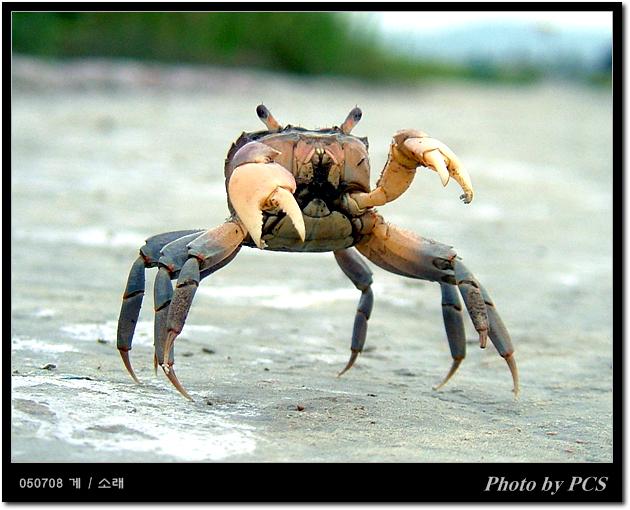


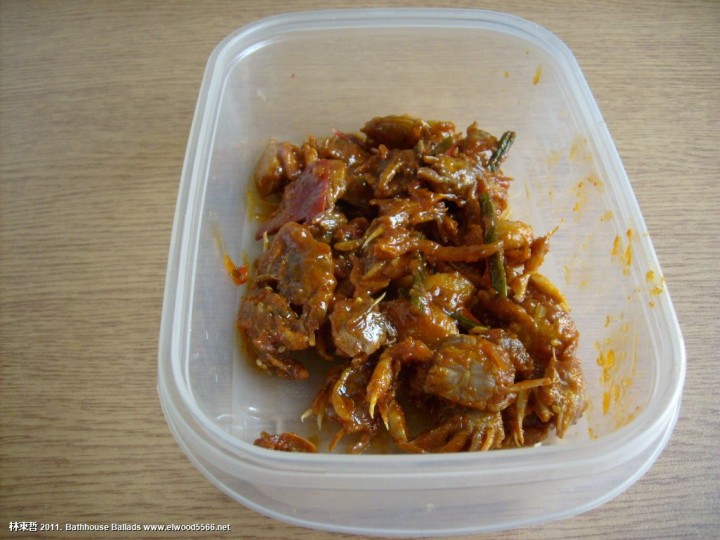

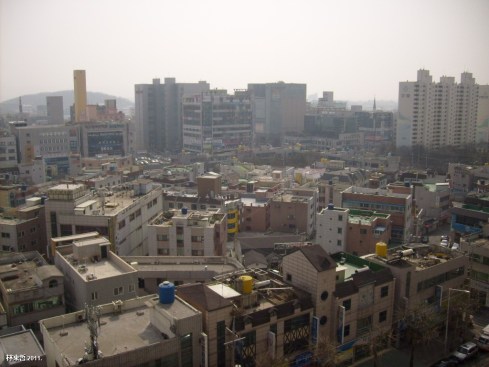



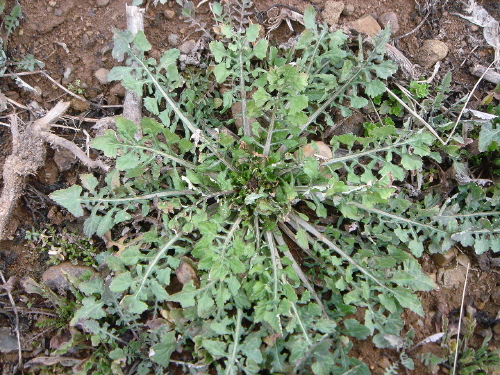

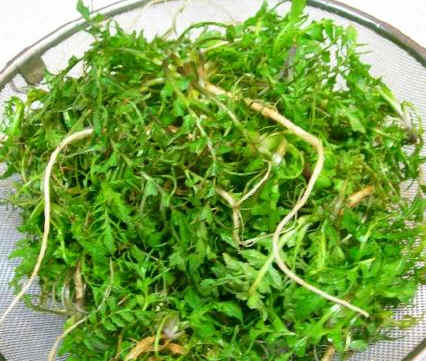

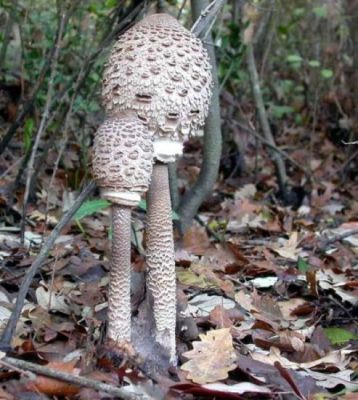
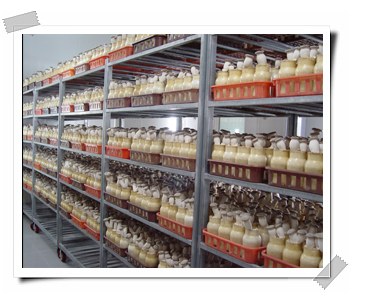


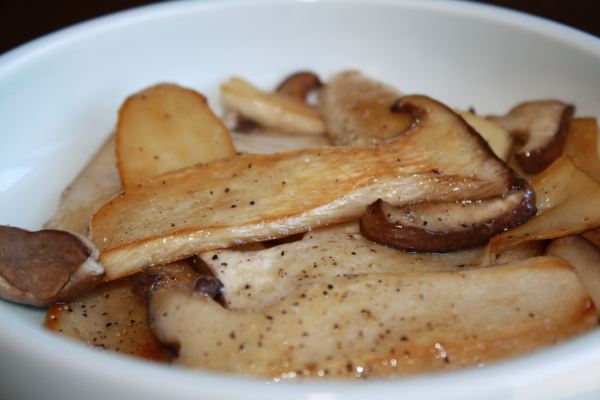
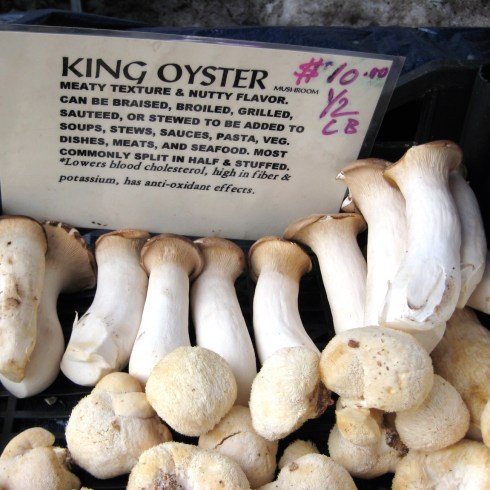







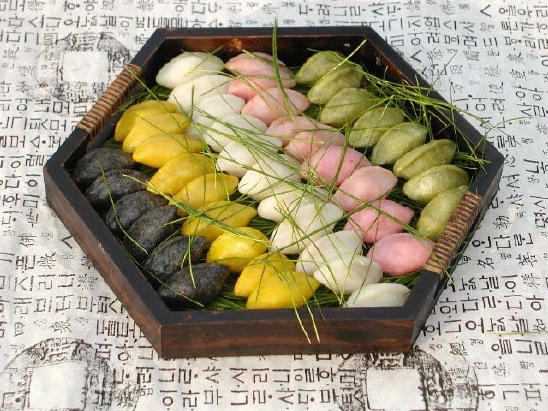



leave a comment